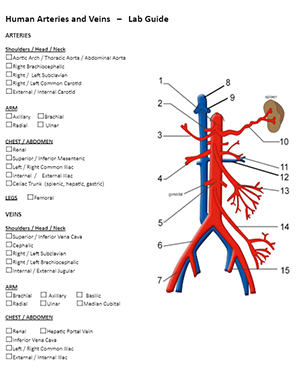
In my anatomy and physiology class, students focus on how the circulatory system delivers blood to body tissues. The first part of the unit focuses on pulmonary circulation, the anatomy of the heart, and heart health.
In the second part of the unit, students learn the names of the major vessels. I try to teach students to not memorize images, but to instead view the vessels like a road map.
For example, the arch of the aorta has three branches, the brachiocephalic, which branches into the right common carotid and the right subclavian. The middle branch is the left common carotid followed the the left subclavian. We then trace the flow of blood into the arms and into the chest and stomach regions.
I try to focus on the main arteries, which can still be quite challenging for high school anatomy students. Students label a handout as I show them on overhead slides the path blood takes from the heart. A single lab guide has a list of all the vessels that students need to know for a final “lab test.”
Unit Overview
This unit takes approximately three days:
- Arteries and veins of the heart, neck, and arms
- Arteries branching from the abdominal aorta
- Veins branching from the inferior vena cava
Finally, a day can be reserved for review and labeling practice. I have anatomy coloring books that I sometimes copy relevant pages for students to color. Unfortunately, many of these diagrams are too detailed for what I have the time to cover in class.
This is also a good time to review body region names. Many of the words they need to know are not unfamiliar to my students. For example, they already know that “iliac” refers to the bowl-shaped bone of the pelvis. They can use prior knowledge to apply to the location of the common, internal, and external iliac vessels.


